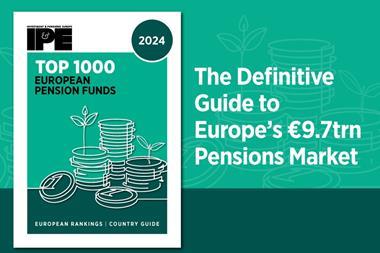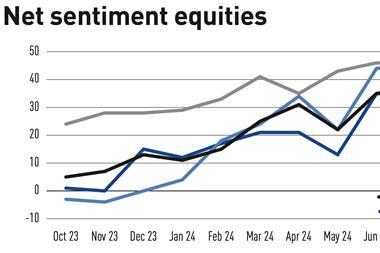Pension plans today are facing a new paradigm of investing where it no longer suffices to follow upward trending markets over full cycles. Too many consecutive, negative periods have surreptitiously eaten into funding ratios for pension plans to simply watch their asset pools dwindle due to tumbling markets. In defence, they are adopting more innovative techniques in managing pension assets, particularly in an environment where protecting wealth is quickly becoming paramount to pursuing simple rates of return.
Innovation in pension fund management ranges from mainstreaming hedge fund investing as a stable percentage of allocation to rethinking the strategic benchmark as a means of budgeting and controlling active risk. A portfolio invested in the S&P Hedge Fund Index for the year 2002 would have achieved a performance of 20%(1); a return to make even the most traditional asset allocator turn green with envy. Yet, somewhere between hedge fund investing and traditional active management of blue chips lies enhanced indexing, composed of individual stock-based, arbitrage-based or asset class-based approaches.
Before the prolonged bear market, overall upward market momentum may have shaded the median active manager who underperformed his benchmark. But as managers, and plan sponsors themselves, are under constant pressure to produce excess returns, the appeal of risk-controlled strategies relying on enhanced indexing has gained strong interest.
There are innumerable combinations of skills, styles and techniques to implement an investment programme. But what underlies the initiation of any programme is the definition of its risk factors: what downside would be acceptable and over what period? And consequently, to which asset classes or sub-classes should the portfolio be exposed? Most pension plans continue to define their asset allocation before attributing mandates and thus, directly decide on their most important source of portfolio return. Fine-tuning the strategic benchmark can enhance control over the portfolio with regard to cost-effectiveness and the objective information ratio, resulting in better investment results.
Plan sponsors generally prefer limited risk strategies in a range of 3% to 5% tracking error (T/E) relative to their strategic benchmark. So when distributing that 5% or so of tracking error across the portfolio, pension plans tend now to lower the T/E allowable for strategic asset classes where markets are more concentrated, and to increase this allowance for asset classes where market inefficiencies justify specific, higher risk tolerances in the search for alpha. The result is a multiple beta portfolio where the sum of asymmetric risk allowances does not significantly alter the risk profile of the total allocation.
The key to enhancing the strategic benchmark is to initiate techniques that operate independently and have low correlations with each other. Core/satellite is one example of enhancing index strategies.
As an illustration, we have designed a two-dimensional core-satellite strategy to show how investors may be able to reduce risk and enhance returns by employing what effectively should be an easy to implement investment strategy.
We constructed a model European portfolio. A portfolio with 75% core European equity, 5% industry momentum(2), 10% European small caps(3) and 10% hedge fund exposure giving a three-year alpha of 3.98% and a tracking error of 3.15%. The performance of this portfolio is shown in Exhibit 1. Of course, the index weights have to be periodically balanced by the portfolio manager in order to remain in line with specific tracking error requirements.
Given all the choices, our benchmark selection was the first key investment decision. The principle core weight of the S&P Europe 350 and the S&P Hedge Fund satellite were chosen because both are benchmark indices that afford cost-effective replication of their opportunity set by offering:
o market representation that reconciles broad exposure with investability of index constituents and low index turnover
o transparency and consistency of approach
o multiple portfolio management tools that accentuate index tradability and liquidity
o a complete family of benchmark indices providing further opportunities for diversification and coherency within a same portfolio
Typically, very broad indices are designed to measure performance of their total universe, and hence do not screen liquidity of underlying securities as a criteria for inclusion. Yet money managers must be able to efficiently buy and sell each index constituents when attempting to achieve comparable performance. As such, pension plans would do better to integrate benchmark indices that are designed not only with market representation but also with underlying constituent liquidity in mind.
The S&P Europe 350 and the S&P Hedge Fund indices combine these two distinguishing features, making them ideal for portfolio management and differentiating them from every other index available for comparable market exposure.
Our analysis was done by individually comparing each of the satellites with the core in order to determine the applicability of each of the individual satellites. All of our alpha strategies outperform the core on an individual basis and demonstrated a statistically significant difference in returns, as they operate independently and have low correlations with the core.
Finally, we performed a scenario analysis of various levels of core and satellite weightings. We observed the following: greater allocation for satellite strategies leads to greater alpha, but at an expense of greater tracking error, also the information ratio does not radically change for different combinations of core and alpha strategies. This shows that the level of allocation for alpha strategies is a trade-off between alpha and tracking error.
It is also interesting to note that once the core allocation is fixed, variations of holdings between the different alpha strategies did not significantly impact the alpha over our three-year horizon.
Given the above findings, a core/satellite strategy that fine-tunes the strategic benchmark finds applicability among risk adverse investors and can be used to enhance index returns on different asset classes. We also find that, given the liquidity of the S&P Europe 350 and S&P Hedge Fund indices, the implementation of this strategy is possible to undertake without incurring excessive trading costs. We also think that there are many permutations and combinations possible using indices as investment vehicles and that the above simply illustrates the process that we would employ in order to arrive at different optimum portfolios.(4)
Christopher O’Brien, director of market development, is based in Standard & Poor’s Paris office
(1) Based on pro forma index performance data.
(2) Based on the 3 best performing Industry Group Sub-Indices of the S&P Europe 350, from the previous quarter.
(3) Based on MSCI Smallcaps Europe Index.
(4) The above study was performed by the S&P Index Services and the S&P Quantitative Services Group. Neither is mandated to manage any investment funds, and such studies are performed in order to illustrate the different ways that indices may be used in investment programmes.












No comments yet